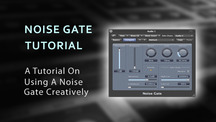Among the most underrated of mixing tools is the noise gate. It can do wonders for cleaning up loose sounds and emphasizing various aspects of a sound’s dynamics. A lesser known fact is that it can be used as a unique creative processing tool. In this noise gate tutorial we will look at one way of doing this by combining Logic’s noise gate with some creative routing techniques in order to create a dynamic auto panner.
Although this tutorial is in Logic Pro, the same process can be used in many DAW's with a noise gate.
Set Up
If you are unfamiliar with noise gates, the controls are fairly simple and I would suggest looking in your product manual for a more in depth explanation as this tip is going to assume some degree of basic knowledge.
What we are going to make is an effect that pans a signal according to its level. In this case, a reverb which pans left when it’s output is above a certain level and pans right when it’s output is below that same level.
For this example, I have instantiated Ultrabeat and sent a clap to direct out as well as a reverb aux. I have then compressed the reverb (more on why I did this later) and sent the reverb to two aux. channels where I have placed noise gates. I have then sent the two gated verbs and the dry clap to a single aux. (just for added control) and sent that to my stereo out.
Closing The Gate
I am now going to solo one of the gates and bring up the threshold until my reverb begins to chatter (the gate opens and closes very fast as the signal is centered around the threshold) which is made more prominent due to the compression evening out the signal earlier in the chain.
From here, I will input the threshold setting into the second gate, but instead of having it cut the signal at the threshold, I will boost it by reversing the gain slider. Now the first gate will let the signal pass only above the threshold and the second gate will do the opposite and only let the signal pass below the threshold.
From here I can pan the two signals to opposite ends of the stereo spectrum or do any other number of things to each channel individually to create an auto panning effect (and then some) that responds to the signal dynamics. The possibilities are literally endless
Original source from our friendsat http://audio.tutsplus.com













